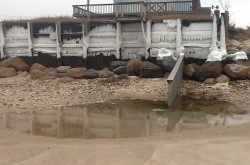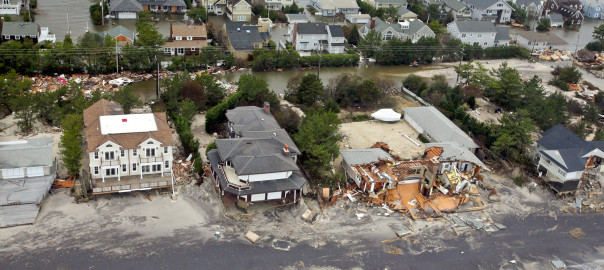Podcast: Play in new window | Download
Subscribe: Apple Podcasts | RSS
Kathryn Miles talks about her gripping moment-by-moment account of the biggest Atlantic storm ever recorded, Superstorm: Nine Days Inside Hurricane Sandy (Dutton 2014).
And beachfront homeowners are trying to save their property from sea level rise and storm surge by building hard structures to keep the ocean at bay. But at what cost to the public? And does it even work? Marine scientist Doug Hardy talks about his report for his local conservation advisory council, “The Starvation of Southold’s Beaches.” It’s got lessons for every coastal resident — and every US taxpayer.
Kathryn Miles
 As of this posting, Boston is readying itself for another big snow storm. Over the past 17 days, the city has seen 77 inches of the white stuff fall. Winter storm Juno at the end of January didn’t just bring mountains of snow to eastern Massachusetts — it also pummeled coastal communities with destructive storm surges.
As of this posting, Boston is readying itself for another big snow storm. Over the past 17 days, the city has seen 77 inches of the white stuff fall. Winter storm Juno at the end of January didn’t just bring mountains of snow to eastern Massachusetts — it also pummeled coastal communities with destructive storm surges.
Scientists say that climate change most likely has a part to play in the giant storms that are battering the Northeast ever more frequently. The mother of all such storms is still fresh in the memory of countless residents of New York and New Jersey — Superstorm Sandy. It was the largest Atlantic storm system ever recorded, the second costliest storm in US history and one of the most deadly: 117 Americans lost their lives.
Kathryn Miles has written the first complete account of what happened during the nine days of Sandy’s life, from when it first formed way out in the ocean until it slammed into the eastern seaboard in the waning days of October 2012. She tells how Sandy was like no other storm before it: a hybrid of hurricane and nor’easter, it overwhelmed the weather scientists who were tracking it. Government leaders like NYC’s take-charge mayor Bloomberg were left haplessly scrambling to cope.
 Miles shows the toll that years of underfunding has taken on the infrastructure the US uses to forecast deadly storms, leaving us vulnerable to the storms of the 21st century. But she also tells the stories of Sandy’s heroes — those who risked life and limb to rescue others caught in the storm’s gigantic waves.
Miles shows the toll that years of underfunding has taken on the infrastructure the US uses to forecast deadly storms, leaving us vulnerable to the storms of the 21st century. But she also tells the stories of Sandy’s heroes — those who risked life and limb to rescue others caught in the storm’s gigantic waves.
In addition to Superstorm: Nine Days Inside Hurricane Sandy, Miles is the author of two other books, All Standing and Adventures With Ari. Her work has appeared in dozens of publications including Best American Essays, Outside, and The New York Times. She teaches writing in Chatham University’s MFA program. She lives in Maine.
Doug Hardy
The battle over the coast is heating up. On eastern Long Island, every week the local papers are filled with news about lawsuits pitching homeowners against town trustees.

The wealthy like to build their mega-mansions on the beach. As the changing climate threatens to wash away their property with rising seas and surging storms, they build seawalls and groins to try and hold back the ocean. But those “hardened” structures increase the velocity of the waves, scouring adjacent beaches of their sand and worsening the erosion of the coast.
Meanwhile, town trustees are charged with protecting public beaches under the Public Trust Doctrine. They’re trying to hold back the tide of money and power that is riding roughshod over the coastal commons.
One community facing the conflict between coastal resilience and protecting private property is Southold, on the north fork of eastern Long Island. Retired marine scientist Doug Hardy was commissioned by Southold’s Conservation Advisory Council to write a report for the town about the issue. It’s titled, “The Starvation of Southold’s Beaches.”
(This interview was originally produced for Sustainable East End, a local radio show on sustainability Francesca co-produces with Tony Ernst for community radio station WPKN 89.5 out of Bridgeport, CT and broadcasting to communities in Connecticut and on Long Island.)

